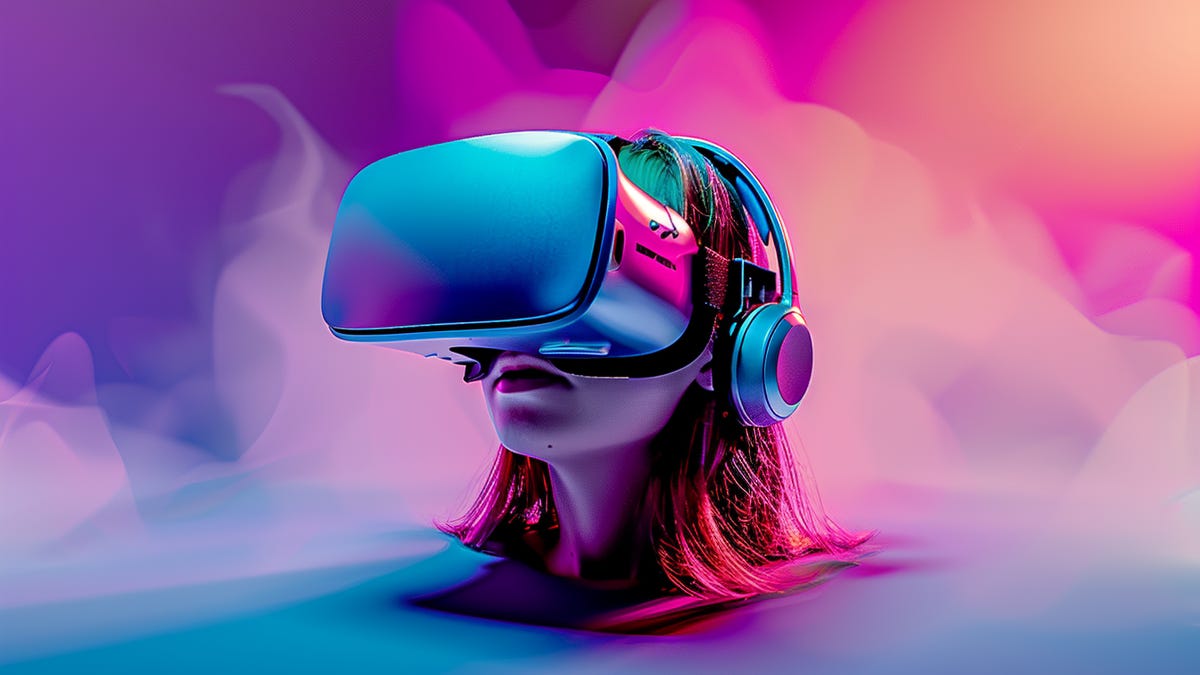Samsung, Google and Qualcomm are teaming up on a new mixed reality project. Could it be Android’s answer to the Apple Vision Pro? Or perhaps a pair of AI-powered smart glasses, like Meta’s Ray Bans?
We have no idea. Other than confirming their collaboration, none of these companies have said much about what the product could look like, its functionality or when it will arrive. But Google’s Rick Osterloh did show up at Samsung’s recent Unpacked product launch event in Paris to assure audiences that the initiative is still in the works.
“Looking forward, we’re collaborating to bring next-generation experiences across Galaxy products, from smartphones and wearables to even future technologies, like the upcoming XR platform we’ve been working closely to develop in partnership with Samsung and Qualcomm for next-generation devices,” he said. “And you’ll want to stay tuned for that.”
The three companies, which form the backbone of the Android landscape, are certainly reentering the mixed reality world at a time of growth and change. The debut of Apple’s Vision Pro mixed reality headset in early 2024 renewed interest in the idea of a computer that can blend graphics with reality. Generative artificial intelligence (i.e. the flavor of AI that powers ChatGPT) has also leveled up virtual assistants by giving them more conversational dialogue and the ability to process sounds, sights and text together, resulting in a new class of wearable devices.
We won’t know what’s in store for Samsung, Google and Qualcomm’s mysterious mixed reality project until the companies have more to announce. But here’s what we can piece together based on interviews with Samsung executives throughout 2023 and 2024.
Read more: The Future of AR Beyond the Vision Pro Is Already Brewing
What we know about the mixed reality project
Neither Samsung, Google nor Qualcomm have discussed details beyond mentioning the broad partnership. When TM Roh, president of Samsung’s mobile experience business, spoke to CNET about the project in early 2023 through a translator, he said the three companies will play similar roles in the platform’s development as they do in the existing Android ecosystem.
Samsung and Google currently make their own respective Galaxy and Pixel-branded Android devices. And while Google is the purveyor of Android, it does collaborate closely with Samsung on certain implementations like the Wear OS software for smartwatches. Qualcomm, meanwhile, supplies chips for many Android phones, including those made by Samsung.
“Each player is taking leadership in each category, and then we will be working very closely together across the different categories,” Roh said.
We know the chipset it will use, though, which could suggest a lot: Qualcomm announced that the Snapdragon XR2 Plus Gen 2 will be what’s inside the Samsung/Google/Qualcomm product. The chip is an updated version of the processor that powers Meta’s Quest 3 headset. That information indicates that the device will likely be another VR-like headset rather than glasses, and probably not something particularly small.
A new mixed reality chipset from Qualcomm beefs up display resolution and simultaneous sensors. Samsung’s next headset will be using it, and Qualcomm has its own developer-focused reference design.
A platform rather than a product
Samsung, Google and Qualcomm’s goal is to establish a new open platform for mixed reality, perhaps in the way that Android has for smartphones. Based on previous conversations with Roh, it sounds like the project isn’t about developing one specific product, but a new ecosystem for mixed reality that perhaps extends beyond products made by Samsung and Google.
A year ago, Roh described the vision as being an “open platform” where “many third parties can participate.”
“It is going to take a longer time,” he said. “But we believe that is the right direction.”
Read more: How Samsung Decides Whether Futuristic Concepts Become Real Products
This open platform approach is exactly the shift Meta’s turned to recently, encouraging third-party hardware manufacturers to make headsets running Meta’s Horizon OS software. Meta has an advantage at the moment because Quest headsets and apps have been a reality for years, but Google has not been a partner in Meta’s plans. Meta CTO Andrew Bosworth has welcomed Google to bring its Google Play app store to Quest, but that isn’t happening right now. And without Google onboard, Meta still stands on its own with an app ecosystem that doesn’t live on phones or tablets.
Google, meanwhile, has a giant software infrastructure that lives across many devices. So does Samsung. Whether that’s headsets or phones, tablets and PCs, Google and Samsung would have a big advantage on Meta in that regard.
Google made an appearance at Samsung’s event to briefly discuss their partnership.
Productivity might be a focus
In terms of the use case and need for such a device, Roh sees potential for mixed reality to elevate everyday experiences, such as teleconferencing and viewing content on a significantly larger virtual screen than your phone.
That sounds a lot like Apple’s intention with the Vision Pro, and it also lines up with a more recent conversation CNET had with Patrick Chomet, Samsung’s executive vice president and head of customer experience. Just before Samsung’s July 2024 Unpacked event in Paris, he mentioned productivity as being an interesting use case for mixed reality.
It might start with phones
The challenge with standalone headsets, though, is replicating human senses such as three-dimensional vision and hearing in a virtual space. That’s why Roh believes that some mixed reality features and experiences may initially rely on smartphones.
“So for the short term, perhaps many features or experiences [in] mixed reality would be in connection with [the] smartphone,” Roh told CNET last year.
But that could eventually change as the technology evolves, he added.
“For the mid-to-longer term, I believe that many applications could be mixed reality only,” Roh said. “A new experience, a new [user interface] or even new [app] stores…I believe that they can be created out of mixed reality itself, meaning that they could be specifically for mixed reality not in connection with the smartphone.”
Read more: After 6 Months, These Are My Favorite Samsung Galaxy AI Features
Will Samsung, Google and Qualcomm’s mixed reality platform rely on phones? We’ll have to wait to find out.
Artificial intelligence will play a big role
AI has been a big theme for Samsung — and the tech industry at large — throughout 2024. So it’s not surprising to learn that this upcoming mixed reality project could incorporate AI in a big way.
Chomet couldn’t share specific details. But when speaking broadly about AI, he said that “multimodal intelligence” — AI that incorporates images and speech input in addition to just text prompts — already makes software better at understanding the user’s intention. The “immersive part” would come next.
“The computing power is very important, [the] multimodal interaction,” Chomet said. “But I believe the whole thing, what will make it really, really useful for people is actually AI, which is LLM (large language model) powered AI. So stay tuned.”
Galaxy AI is becoming a bigger part of Samsung’s products. It wouldn’t be surprising to see it play a role in this mysterious upcoming mixed reality platform.
Google fueled speculation about future smart glasses after its Project Astra demo at Google I/O. Project Astra is a prototype for a virtual assistant that scans your surroundings and understands speech, and would seem right at home in a pair of tech-enabled glasses. Meta’s Ray-Ban glasses, which are equipped with cameras and microphones, can already “look” at the world around you and answer questions based on what it sees.
Meta may start to incorporate AI into its Quest headsets soon, and while Apple hasn’t announced Apple Intelligence on the Vision Pro yet, it’s likely going to get Apple Intelligence after iPhones, iPads and Macs do.
What we expect from Samsung, Google and Qualcomm
Samsung made phone-based VR headsets in the mid-to-late 2010s.
Samsung had its own VR devices in the past, and so did Google. Both companies made competing low-cost accessories that turned phones into portable entry-level VR headsets: both Gear VR and Google Daydream were built as entry points to immersive ecosystems that ran off a custom Oculus app and Google’s own Android ecosystem respectively in the mid-2010s. Google had even planned its own standalone Meta Quest competitor, but never followed through. Samsung, meanwhile, even made high-end Windows-compatible PC VR headsets.
Qualcomm has a ton of experience in both VR and AR. Its chipsets power nearly every device on the market, which means that this new device should have every bit as much capability as what’s already out there. The Snapdragon XR2 Plus Gen 2 chip that powers this mystery headset is good at two things in particular: driving 4K displays and providing higher-quality passthrough camera quality for mixed reality that can layer virtual and real experiences together. Both of these advantages sound very competitive with what Apple’s Vision Pro can already do.
It’s important to remember that Samsung, Google and Qualcomm haven’t confirmed any details about a potential new hardware product yet. Comments thus far suggest the three companies are teaming up on a platform. But given that Samsung makes everything from phones to TVs, tablets, laptops and refrigerators — and is the top smartphone maker in the world by shipment volume — it would be shocking not to see a Samsung Galaxy-branded headset.
Google of course will probably play a big role on the software side of things, but keep in mind it has also expanded its hardware offerings over the last decade to include everything from foldable phones to smartwatches and connected doorbells.
Read more: We Asked Google’s Co-Founder About AI Smart Glasses. Here’s What He Said
Google’s Daydream View headset uses your phone as the engine for driving VR experiences.
Given Samsung’s experience in displays and cameras, it seems reasonable to expect that a headset from the company would have excellent visuals. Samsung will probably make a pitch similar to Apple’s — that its headset is a superior wearable cinema. Google and Samsung already have access to media content like YouTube and YouTube Music.
Samsung and Google could also aim to show off immersive 3D video much like Apple, either by using pro camera technology to shoot immersive content (Google has already done this before) or by making phones that can record 3D photos and video to watch in-headset. Would Samsung adapt one of its existing phones to do this, or would the headset be announced along with new Samsung phones with this feature in the winter? Another question still waiting to be answered.
Since Google and Samsung lack immersive gaming or app content — although Google does own Owlchemy Labs, makers of the classic hit VR games Job Simulator and Vacation Simulator — a focus on looking at lots of 2D Google Play apps would make sense. The headset will probably be a big wearable extended display for looking at apps people already use.
The Apple Vision Pro is the iPhone maker’s first venture into mixed reality hardware.
Samsung and Google could leap ahead of Apple with device compatibility. Apple has limited the Vision Pro to only working directly with a connected Mac so far. Samsung could possibly allow its headset to act as a connected display working with phones, tablets, PCs and maybe even watches all at once. Considering Google’s Android and Chrome ecosystems are so different, it might make a lot more sense to start with phones and tablets instead of laptops and Chromebooks. Qualcomm has already focused on the future of headsets working together with phones, and former Qualcomm XR head Hugo Swart recently joined Google.
Qualcomm’s XR2 Plus Gen 2 chipset also allows for up to 12 sensors and cameras to work at once. Apple’s Vision Pro is similarly camera and sensor-studded, which could suggest that Samsung will flood its headset with tons of inner and outer cameras for mixed reality, motion tracking and eye-tracking. Google also has its own radar-based tech called Soli, which can handle near-field gesture controls and seems like a good fit for hand-tracking capabilities.
This could mean an expensive product, and we’d expect a price much closer to Vision Pro than Quest 3. But right now, this is all speculation. We don’t know, and we won’t know until Samsung, Google and Qualcomm finally announce this mystery device, likely sometime in the next year.
New Gestures Will Enhance the Way You Interact with Apple Devices
See all photos


